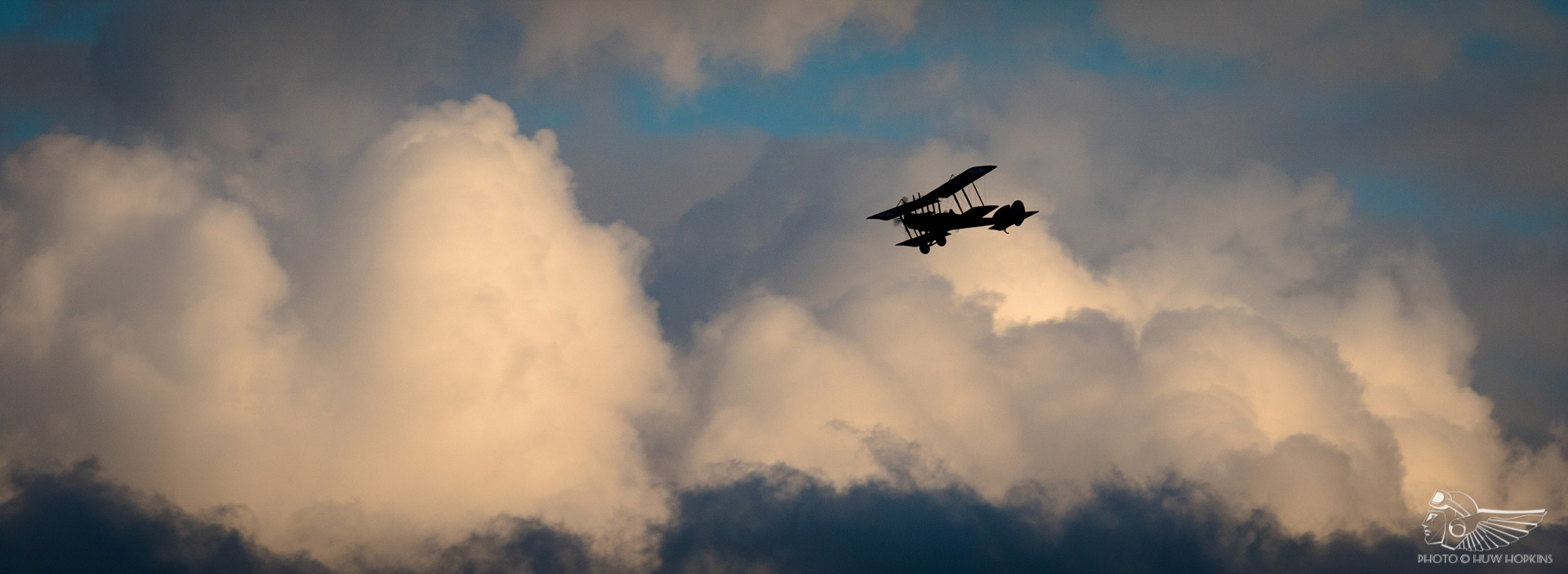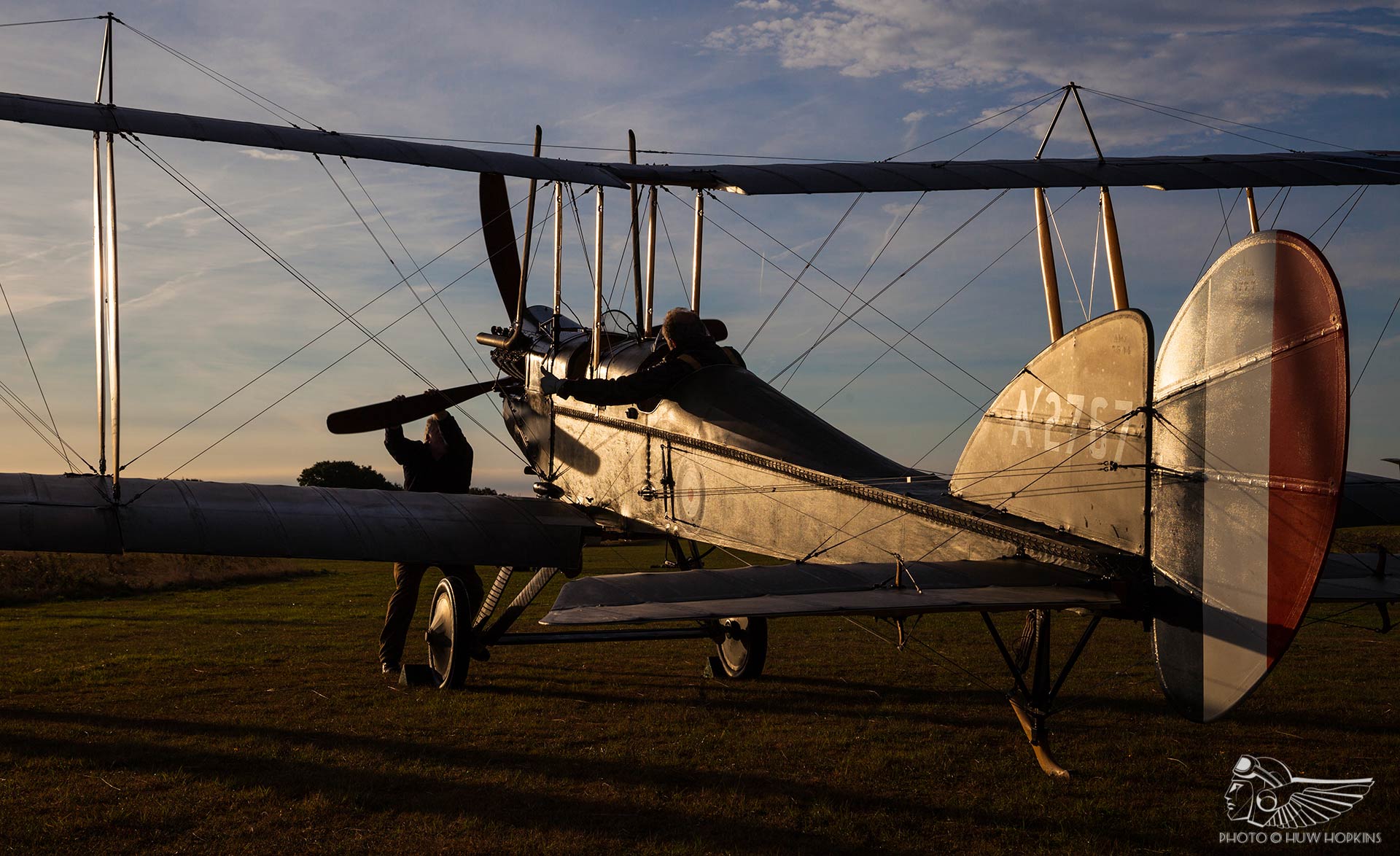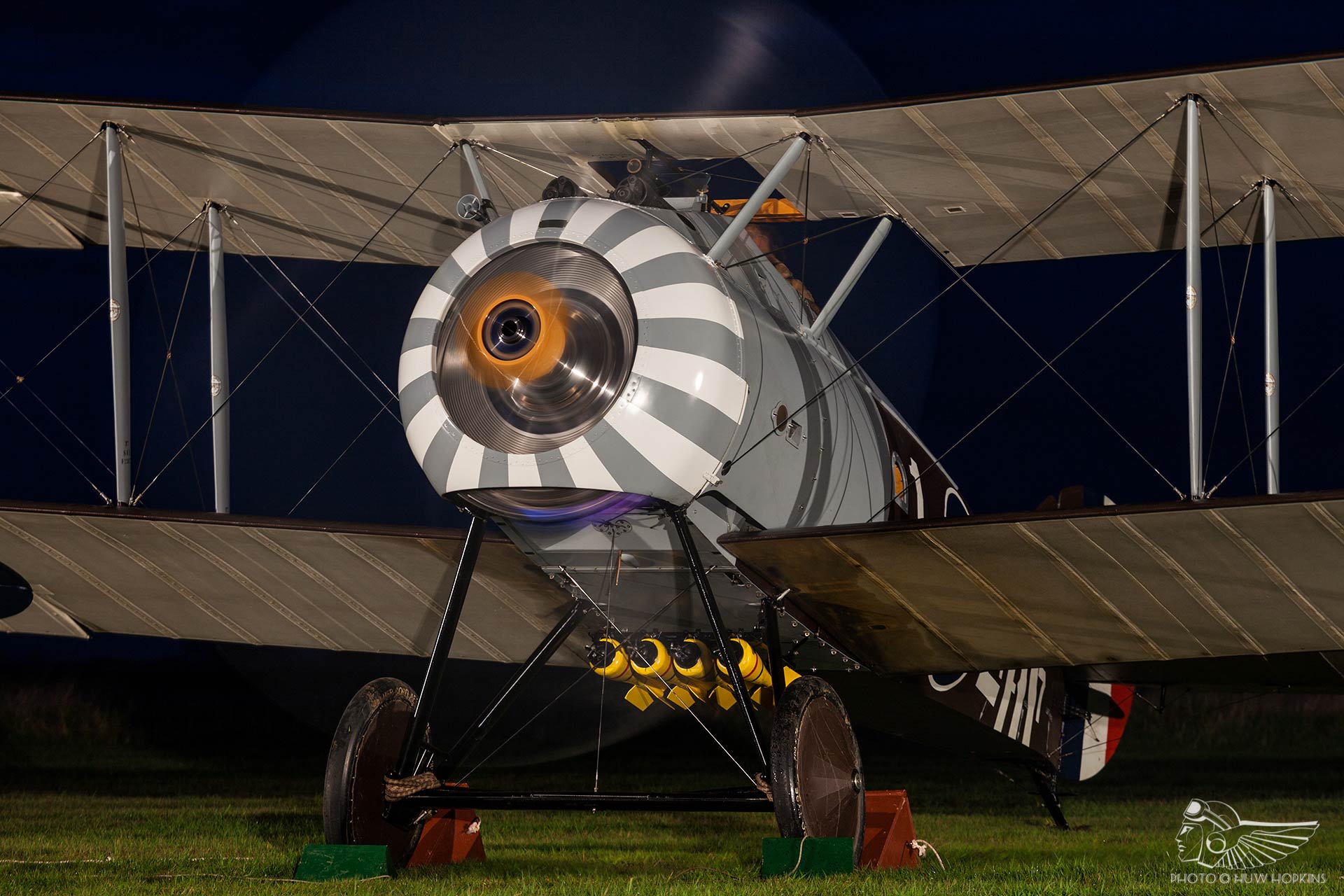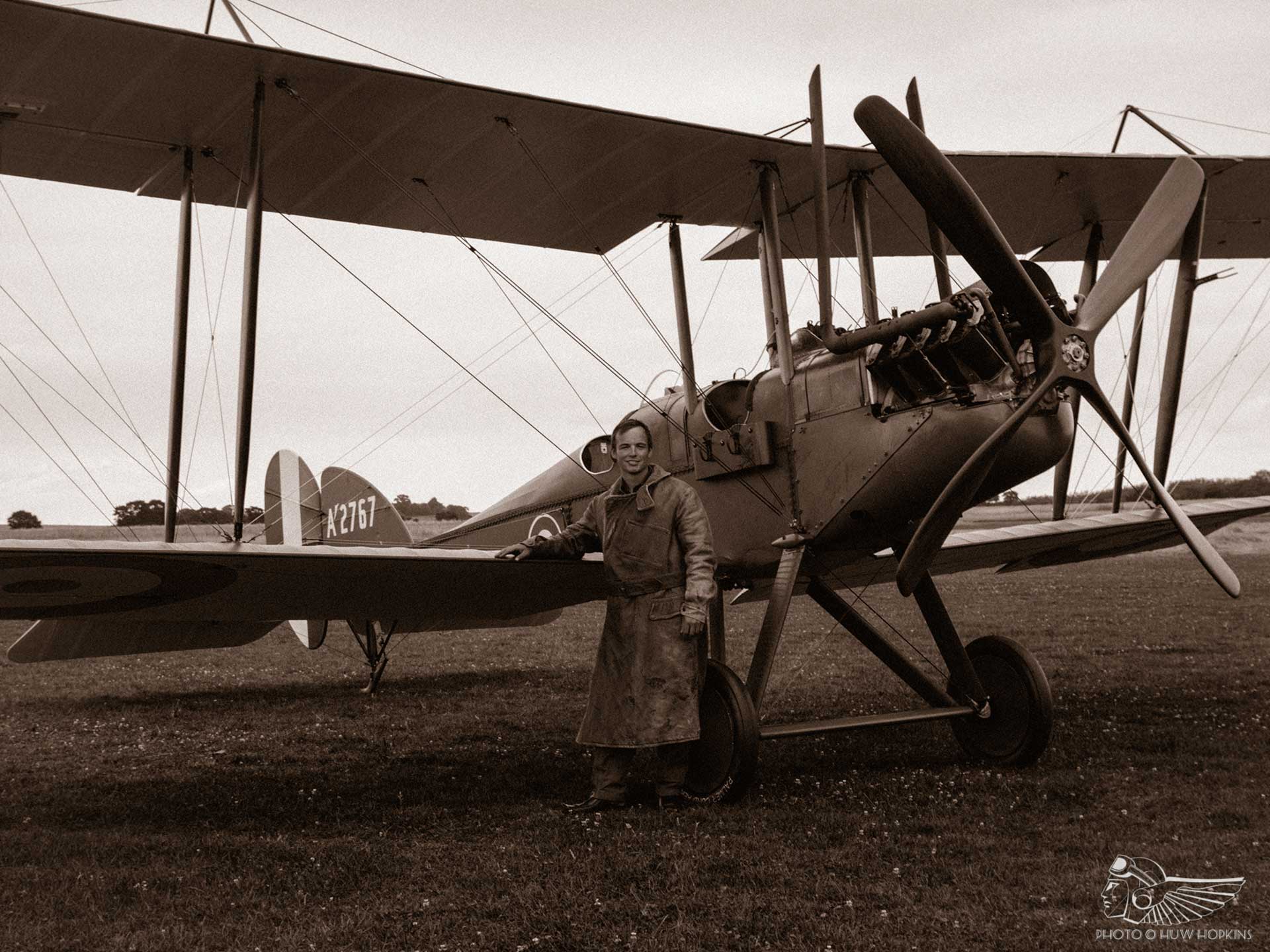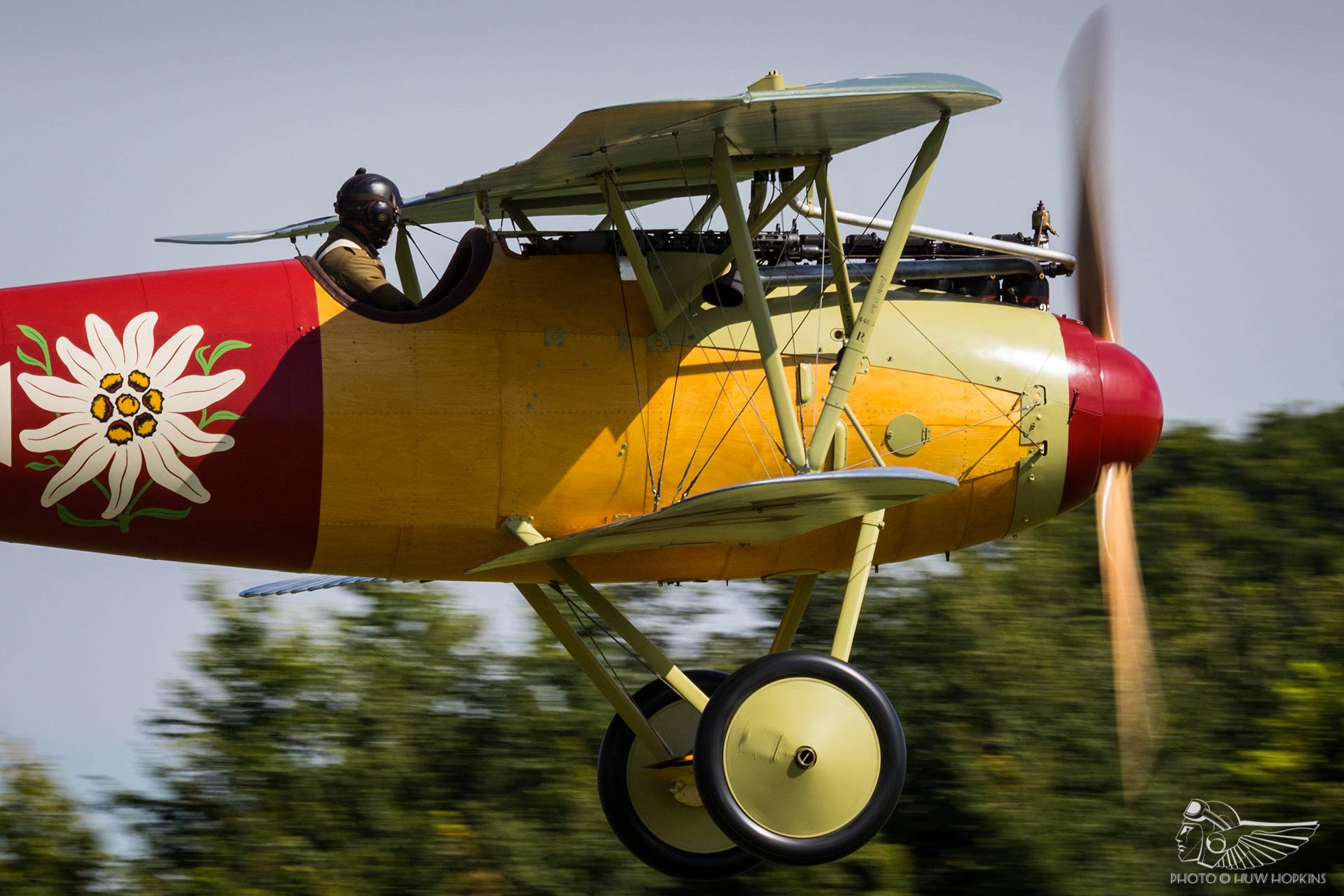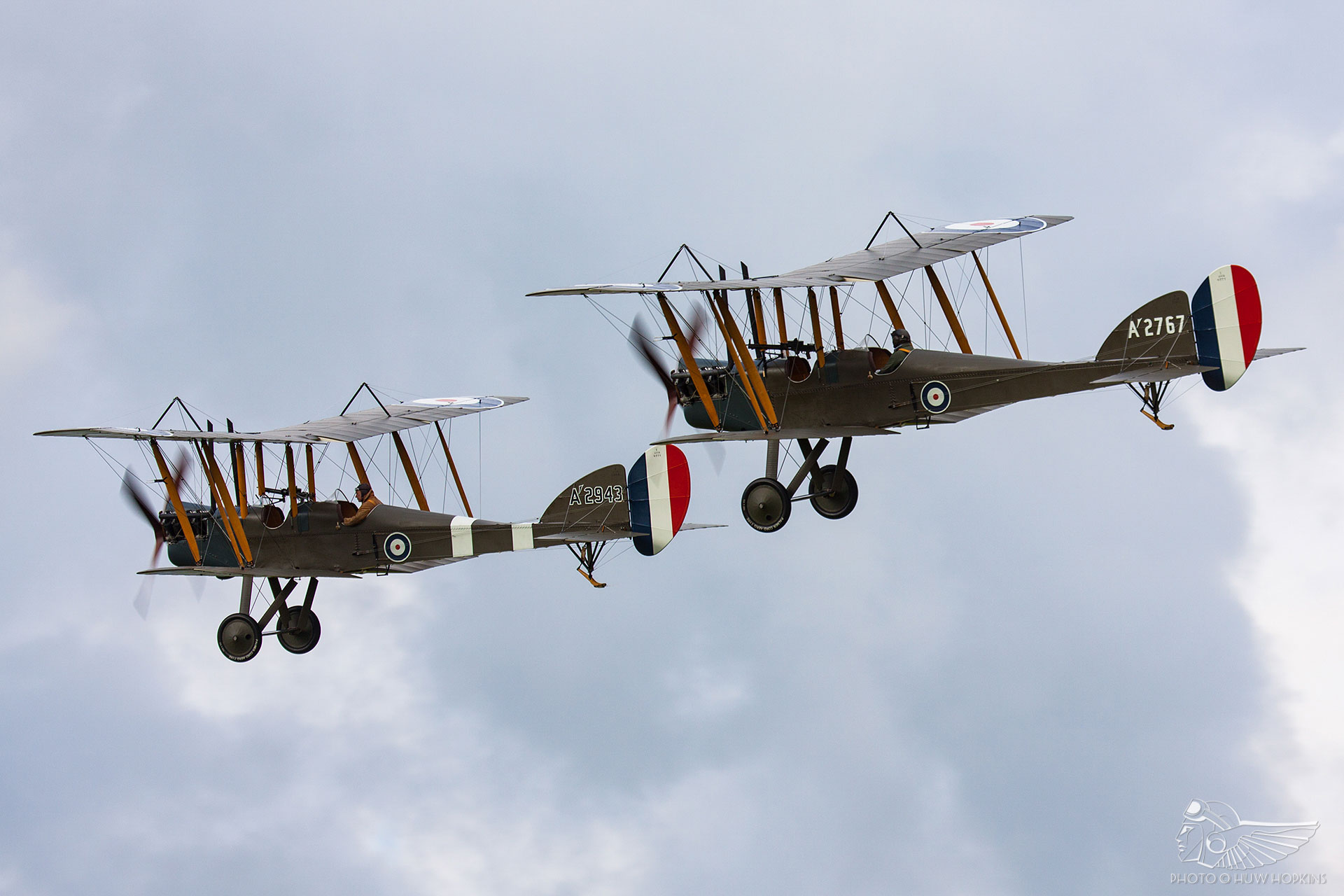A chance encounter between the daughter of a third generation Royal Air Force pilot and the Production Manager of the world’s largest operator of 1914-1918 vintage aeroplanes sowed the seeds for the formation of the World War One Aviation Heritage Trust (WAHT). Chief Trustee Dick Forsythe discusses the WAHT’s ambitious plans to enrich the British historic aircraft movement throughout the Great War centenary and beyond.
Aviation is in Dick Forsythe’s blood. The son of a Lancaster pilot and a Women’s Royal Air Force Intelligence Officer, it was perhaps inevitable that he too would join the service and there he flew numerous support helicopters, including the Whirlwind, Wessex, Puma and Chinook, as well as a stint flying helicopters with the Sultan of Oman’s Air Force. The roots delve as far back as World War One, during which Dick’s grandfather was awarded the 75th Distinguished Flying Cross for his actions in the Royal Flying Corps. It’s highly appropriate, then, that almost a century later Dick would be at the head of an initiative to preserve and display to the public a growing collection of Great War-era vintage aeroplanes.
There’s something rather poetic in how the World War One Aviation Heritage Trust came to fruition. Whilst working on Sir Peter Jackson’s production of The Hobbit in New Zealand, Dick’s daughter Natalie attended an air show at Masterton, home of The Vintage Aviator Limited (TVAL). There, stood alongside a Bristol F2b, she saw Gene De Marco, TVAL’s Production Manager and the most experienced pilot of World War One aeroplanes in the present day, and the two struck up a conversation that naturally touched on Natalie’s great grandfather’s RFC service. Enthused by the chance meeting, Natalie introduced her father to Gene and early conversations were had regarding the possibility of Dick establishing a charitable Trust in the United Kingdom to share the TVAL aircraft with the people of the UK and Europe during the Centenary period and beyond, thus illustrating the evolution of military aviation in the Great War.
Discussions continued apace and in October 2013, the 1914-1918 Heritage Trust established the World War One Aviation Heritage Trust in the UK. In short order the first of the WAHT’s aeroplanes – a pair of rare B.E.2es not seen flying in Great Britain for almost 100 years – were crated up and shipped to Old Warden aerodrome in Bedfordshire for reassembly by Flying Restorations Ltd the following spring. There the dragonfly-like biplanes made their UK airshow debut at July’s Military Pageant, captained by Gene De Marco and Stuart Goldspink respectively.
With their delicate Irish linen clad wings and scratch-built RAF 1a engines, the B.E.2s immediately inspired enthusiasts and the general public alike. Opportunities to see the aeroplanes up close revealed the extent of TVAL’s craftsmanship and stunning attention to detail, with no expense spared in the strive for authenticity. B.E.2e A2943 depicts a No.7 Squadron Royal Flying Corps observation aircraft which operated over the Western Front. Now owned by Dubai-based German collector Oliver Wulff, the aircraft is on temporary loan to the WAHT for the Great War centenary. The second, A2767, wears the markings of a No. 37 (Home Defence) Squadron aircraft which would have operated from a variety of landing grounds, including Stow Maries (more on which later) in the squadron’s home defence role against German aerial attacks on London and the south-east.
Two new types followed the B.E.2s from New Zealand in summer 2015, with the Sopwith Snipe and Albatros DVa un-crated and flown in time to fly at the Shuttleworth Collection’s Best of British Airshow in mid-July. Concluding the flying programme at sunset in one of the high points of the air display year, the pair were absolutely the stars of the show, with the muscular Snipe in particular offering late-war potency and bullish charisma in abundance.
From the offset, Dick had aspirations to bring new aircraft to the UK on a semi-regular basis, both from TVAL and, where possible, other foreign operators. With those aspirations in mind, it was essential for the Trust to establish a suitable home in the UK and that they pursued initially at the large grass airfield at Bicester in Oxfordshire. Indeed, B.E.2 A2943 was initially operated from Bicester and remained hangared at the aerodrome for a time due to lack of hangar space at Stow Maries. However, despite initial hopes that the airfield’s rejuvenation may go hand-in-hand with a blossoming vintage aircraft scene, Bicester Heritage’s keen automobile focus failed to truly align with the Trust’s aims of developing a Great War aviation hub. “It’s a lovely place and a wonderful airfield, but it hasn’t worked out quite the way we planned”, says Dick.
Thus another base was sought, and to that end Dick and Gene came upon the remarkable airfield regeneration project ongoing at Stow Maries in the heart of the Essex countryside. The airfield was built to host Royal Flying Corps units operating in defence of London, its strategic positioning on the Thames Estuary allowing the resident squadrons to respond quickly to German Zeppelin, and Gotha attacks on the capital. The B.E.2s of No. 37 (Home Defence) Squadron took up residence in September 1916, and flew in anger against German aggressors throughout the rest of the war. Following the departure of its operational units in 1919, the aerodrome remained largely derelict for almost 90 years until Russell Savory and his partner acquired the land and began a major conservation and restoration project to revive Stow Maries, carrying out extensive works on the many remaining buildings and reactivating the long disused airfield. The project has progressed at a keen pace, with a Heritage Lottery Fund grant supporting the work on more than two dozen original Great War buildings and, as we sit in 2017, many buildings have been brought back to life by the efforts of Russell Savory and the Stow Maries Great War Aerodrome Ltd team.
Its immersive atmosphere immediately captured the imagination of Dick and the WAHT. “The second time Gene and I went, it was a dark autumn evening and you could see the estuary at dusk. It curled the hairs on the back of my neck – it was very evocative, and the thought of people getting airborne in B.E.2s and then trying to find their way back to Stow at night is quite remarkable.” Partnership between the WAHT and Stow Maries was, then, a positive step for both parties and to consummate this the No. 37 Sqn B.E.2 flew from Old Warden to its new Essex home in summer 2014, followed 12 months later by the Albatros and Snipe. “It’s been a real voyage of discovery. One of the joys has been meeting people along the way, and Russell Savory is a truly inspiring character”, continues Dick.
“We’re much better together than apart”, he says, “and there probably isn’t enough interest in World War One aviation to be separate. With our aeroplanes and other people’s aeroplanes there, it will become a long-term commemoration of the courage of World War One aircrews and the evolution of military aviation from 1914-1918. When people come to Stow and see these aeroplanes fly, their jaws drop. It really illustrates the story we’re trying to tell and the logic of basing ourselves at Stow Maries is indisputable”.
Opportunities to see the WAHT’s aircraft flying elsewhere since their arrival in the UK have been sporadic and should be treasured. WAHT has taken part in events at Old Warden, IWM Duxford and Flying Legends, Goodwood Revival and an increasing number of air shows at Stow Maries, supplemented by a number of commemorative flypasts – an important aspect of the trust that Dick is clearly enthused by – including a cross-Channel trip to the Somme for the 100th anniversary on 1 July 2016, albeit inclement weather sadly put paid to any flying during the actual commemoration. One WAHT flypast was organised by a Kentish village to commemorate local residents who were lost in combat during World War One; villagers had gone to considerable efforts to research the young men named on the cenotaph, including re-publishing one local soldier’s wartime diaries. There was a tremendous sense of pride and remembrance as the B.E.2 overflew the dedication ceremony. “It’s just wonderful hearing people’s stories”, Dick says, “and finding out how people are personally connected to the Great War and to these aircraft is something we’re seeing increasingly as the centenary progresses”.
The aircraft are authentic reproductions of the original century-old types and as such, safe operation is entirely reliant on the combination of calm flying conditions and suitable landing strips, the latter of which aren’t exactly in abundance in 2017. “One of our main limitations is that most airfields have runways these days and few areas of grass for aeroplanes that need to take-off and land directly into wind”, says Dick. “The B.E.2, for example, relies on the tail skid for braking and manoeuvring on the ground, and the skid will get very short very quickly if on tarmac! Even a small side wind puts loads on the undercarriage which is only stressed fore and aft, and once in the air, the aircraft is challenging to fly in anything approaching turbulence. All flying is about risk management, but when the pressure to deliver something is all powerful, you take risks. It’s quite natural that in World War One these aeroplanes were bent and flown beyond their capacities quite frequently because the situation demanded it. When you get to where we are now and preserving the aeroplane is the imperative, you obviously don’t take the risks you would in a combat situation.”
Until recently, the four aeroplanes managed by the Trust had flown in the UK on a New Zealand Certificate of Airworthiness, operated under TVAL’s authority and maintained by Flying Restorations’ engineers. “The rules about operating on a foreign COA are quite strict in that you are limited to 28 days’ flying per year, and you must apply for an exemption for every day that you wish to fly”, Dick explains. “TVAL had an initial visit by the UK Civil Aviation Authority some while ago through Shuttleworth Chief Engineer Jean-Michel Munn’s involvement, so they are well aware of TVAL’s near mass-production standards of vintage aeroplanes and their engineering standards. It hasn’t caused us any problems at all and we fully understand the regulations we need to comply.”
Over the past months, the Snipe and B.E.2es have been added to the UK civil register, and as of spring 2017 the WAHT team is working to obtain permission to continue to fly the aeroplanes. A core group of five vastly experienced aviators fly the aircraft, including Gene De Marco during his visits to the UK. The Albatros and B.E.2es have been flown by Jean-Michel Munn, Stu Goldspink, Rob Millinship and Rob Gauld-Galliers, whilst Gene and Jean share responsibility for piloting the Snipe.
Unfortunatey, the Albatros came to grief in summer 2016 following technical issues whilst TVAL pilot Keith Skilling was ferrying the aircraft from northern France to Headcorn, Kent. Thankfully, the pilot walked away unhurt but the aircraft requires considerable repairs. The Albatros will be shipped back to New Zealand to complete the requisite repairs, and it is hoped that it will return to the UK in the company of another reproduction Great War fighter – more on which later.
The first New Zealand imports are, as Dick explains, hopefully the beginning of a more consistent movement of aeroplanes to and from the UK. “What I had in mind was to have a rotation of four to eight aircraft every couple of years to refresh the offering”, he explains. “I had hoped to tell the story as we evolve through the centenary period, but we’ve jumped ahead with the Albatros and Snipe! Ideally I’d like to have around five permanently resident in the UK and either owned by the Trust or by other individuals, with others rotated via TVAL on a short-term loan. There are a lot of factors involved, but we’re gradually telling the story.” Naturally, Stow Maries plays heavily into the Trust’s ambitions and once the authentic reproduction Great War wooden aircraft sheds are constructed at the aerodrome, Dick hopes to establish “a permanent engineering set-up at Stow, together with an apprenticeship scheme to foster the husbandry and skills associated with looking after old aeroplanes”.
Small steps have already been taken in this regard. Following a £10,000 Heritage Lottery Fund grant, students from the Colchester Institute have worked with the WAHT to design and manufacture a reproduction ‘rocking nacelle’ simulator which takes pride of place at Stow Maries. Dubbed Project Lanoe in honour of the nacelle’s creator, RFC ace Major Lanoe Hawker VC DSO, the initiative’s reach has extended to students at nearby Ormiston Rivers Academy in Burnham-on-Crouch, who have researched Maj Hawker and Stow Maries’ wartime history. Visitors to Stow will be able to enjoy the fully functioning ‘rocking nacelle’ in combination with the new virtual reality flight simulator the WAHT is perfecting.
Currently in the Beta stage of development, this advanced simulator will enable visitors to Stow Maries to carry out a ten minute “flight” in the nacelle for a small fee, whereby they will be able to fly a Great War vintage biplane in computer generated combat, their control inputs reflected both by the nacelle and within the virtual reality simulator. “It’s an elegant mix of 100 year-old mechanics and state of the art modern technology”, says Dick, “and it helps to convey the sense of what young airmen would have been through during the early days of air-to-air combat”. Having tested the in-development virtual reality software at Stow Maries, it’s safe to say that its combination with the nacelle will offer an immersive simulator experience quite unlike any other on the market.
It’s also a moving tribute to Maj Hawker, whose exploits may be further honoured by the WAHT should Dick’s ambitions to import from TVAL a full-scale reproduction Airco DH2 – the RFC pusher biplane the ace was killed in during combat with German ace Manfred von Richtofen’s Albatros – come to fruition. Should that occur, Dick is confident that the DH2 and Albatros would fly together to commemorate Maj Hawker’s climactic, epic duel against von Richtofen.
Yet, without significant investment from private individuals, sponsorship and public support, the Trust will be unable to progress to the next phase of development. Support from enthusiasts and interested parties is vital to the WAHT’s continuation, and for that purpose the trust has established the Patrons of WAHT – or PoW – membership group whereby supporters can pay an annual subscription fee of £30 to enjoy numerous benefits including a quarterly newsletter, and private photo opportunities and an annual BBQ. Current membership stands in double figures but, Dick is keen to point out, with just 1,000 members the PoW scheme would give the WAHT significant annual cash flow of £30,000 from which it could negotiate the loan of greater numbers of TVAL aeroplanes from New Zealand for the centenary period and beyond.
Whilst the rotation of TVAL aeroplanes will continue for as long as funds permit, the prospects of these aircraft remaining at Stow Maries on a longer-term basis are entirely reliant on third party financial backing or, crucially, finding a suitable owner in the UK or Europe. “We can cover the operation of the aircraft and the maintenance of the Trust,” continues Dick, “and we can maintain our presence as long as TVAL is happy to rotate their aircraft and we can keep them flying in the summer months. But without investment, we cannot progress to the next stage with our engineering hub and expansion plans”.
![]()
To keep up to date with the latest WAHT news, support the Albatros rebuild, or to become a patron of WAHT, visit their website at http://ww1aviationheritagetrust.co.uk/


